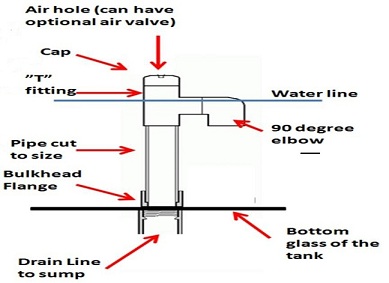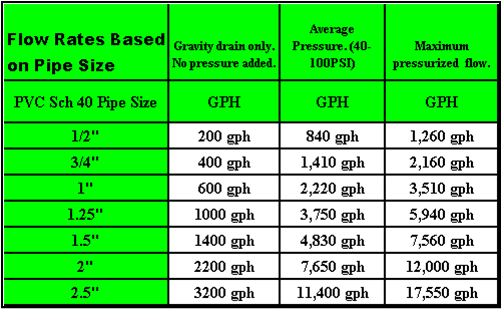Quick question, what is the max gph for full siphon on 3/4 inch pipe?
Navigation
Install the app
How to install the app on iOS
Follow along with the video below to see how to install our site as a web app on your home screen.
Note: This feature may not be available in some browsers.
More options
You are using an out of date browser. It may not display this or other websites correctly.
You should upgrade or use an alternative browser.
You should upgrade or use an alternative browser.
3/4 inch full siphon drain gph?
- Thread starter Mirkus
- Start date
- Tagged users None
- Joined
- Mar 2, 2020
- Messages
- 431
- Reaction score
- 1,227

Found this table and post on here as reference.

Found this table and post on here as reference.
thanks, it looks like 400 gph is not for a full siphon
- Joined
- Jan 3, 2018
- Messages
- 834
- Reaction score
- 699
It depends on the elevation difference and all the fittings, but I doubt it will be a lot more than 400 gph. I run a 1" full siphon with about 30" of elevation drop which necks down to 3/4" through the bulkhead, and an Eheim 1262 pumping against 3 ft of elevation difference through 1" tubing will overload it if I do not throttle it back.
- Joined
- Mar 2, 2020
- Messages
- 431
- Reaction score
- 1,227
Taken from that post, but also can be verified by other internet searches to be approximately the same. I've seen a resource that indicated 660gph from 3/4" pipe, but as distance increased it dropped significantly.
Without getting a flow meter on the end of your siphon, you'd have to approximate it for each application anyways. First column in chart indicates gravity drain.
That post states:
The below charts summarized flow rates by: no pressure, average pressure applications, and the maximum pressure that the pipe and fittings can handle in standard PVC (standard = sch 40). Once I start to talk about an example of plumbing a sump, I will be referring back to these charts
(GPH = Gallons Per Hour )

Loss of flow (this is in regards to loosely calculating head pressure on the return pump).
Once thing to keep in mind, when planning your plumbing set-up the pump should be the last thing you choose. The reason for this is that you need to know how much loss of flow you will have from your plumbing design. Each time you add a 90 degree elbow, or a swing check valve, you will lose some flow because of these additions to your plumbing line. The below list are more of a rule of thumb with calculating flow loss of your pressurized return line only. They may not be 100% accurate, as many other factors can effect these calculations. They will be close enough for you to get an accurate estimate of the flow reduction. The below factors will become very important when planning your set-up.
• A loss of 75 to 125 GPH for each foot of height (from the pump to the display tank return)
• A loss of 50 to 75 GPH for each 90 degree elbow
• A loss of 30 to 50 GPH for each 45 degree elbow
• A loss of 50 to 75 GPH for each swing check valve
• A loss of 20 to 40 GPH for each ball valve
• A loss of ~ 3 to 5 GPH for each union
Without getting a flow meter on the end of your siphon, you'd have to approximate it for each application anyways. First column in chart indicates gravity drain.
That post states:
The below charts summarized flow rates by: no pressure, average pressure applications, and the maximum pressure that the pipe and fittings can handle in standard PVC (standard = sch 40). Once I start to talk about an example of plumbing a sump, I will be referring back to these charts
(GPH = Gallons Per Hour )

Loss of flow (this is in regards to loosely calculating head pressure on the return pump).
Once thing to keep in mind, when planning your plumbing set-up the pump should be the last thing you choose. The reason for this is that you need to know how much loss of flow you will have from your plumbing design. Each time you add a 90 degree elbow, or a swing check valve, you will lose some flow because of these additions to your plumbing line. The below list are more of a rule of thumb with calculating flow loss of your pressurized return line only. They may not be 100% accurate, as many other factors can effect these calculations. They will be close enough for you to get an accurate estimate of the flow reduction. The below factors will become very important when planning your set-up.
• A loss of 75 to 125 GPH for each foot of height (from the pump to the display tank return)
• A loss of 50 to 75 GPH for each 90 degree elbow
• A loss of 30 to 50 GPH for each 45 degree elbow
• A loss of 50 to 75 GPH for each swing check valve
• A loss of 20 to 40 GPH for each ball valve
• A loss of ~ 3 to 5 GPH for each union
Similar threads
- Replies
- 1
- Views
- 63
- Replies
- 18
- Views
- 234
- Replies
- 5
- Views
- 183















